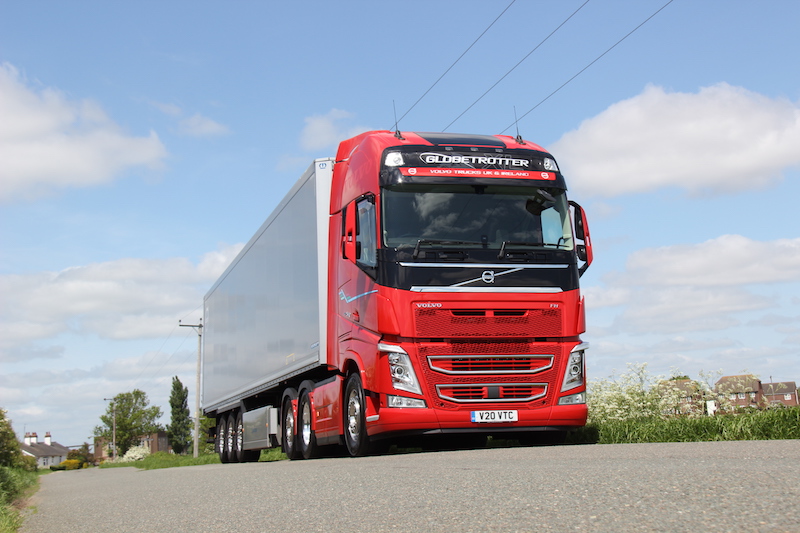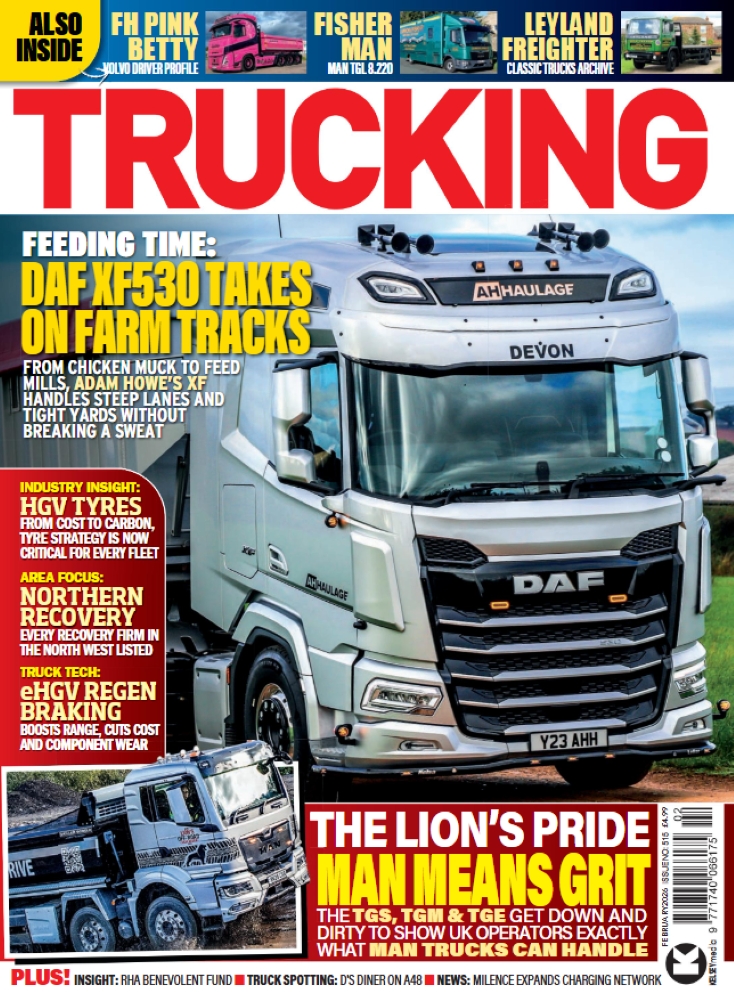Rear tag-axle tractor units might not be as popular as their midlift cousins, but Volvo’s new rear-steer could change all that. Trucking went for a drive in a FH13-540 to see how it performs.
Take a trip on any motorway or main road in the UK and you’ll see plenty of Volvo FH tractor units, and the model is a popular machine for both owner drivers and small and large fleets.
While fleet operators are most likely to opt for the ‘plain vanilla’ FH13-460 or FH13-500 models, they are just two of several options in what is a very varied and flexible product range, which also includes the impressive FH16. In short, the FH is versatile and varied and can be specified to meet all manner of applications, including rigids.
In the three-axle tractor unit market, you are most likely to see examples with a centre midlift axle ahead of the drive axle. But while those with rear, non-driven tag axles might be in the minority, they still remain popular with operators whose trucks have to go off the tarmac – for example to serve building sites, farms, forests or quarries. These applications often mean traction can be compromised, and it is here that tag-axle units come into their own – which explains why you see lots of them in Scotland. Lifting the rear axle gives improved traction to get the driver out of any sticky situation.
However, tag-axle trucks can have poorer turning circles when compared with a midlift, and also the overhang of the rear axle means the truck ‘pivots’ differently which can cause issues when manoeuvring. They also tend to be a little heavier than a midlift.
But Volvo is now offering a rear-steer option on its tag-axle tractor units, and this is all to improve the manoeuvrability of the models. The option is available on FM, FMX and FH models.
Rear-steer tag-axles are a new feature for UK operators, but they have a great advantage: they increase the manoeuvrability. So, in theory you can have the best of all worlds: a lifting tag-axle for traction, reduced tyre wear when running empty; and a steering axle for when you’re loaded, yet need to get into tight spots. The overhang of a non-steering tag axle can be quite something.
But the question is: how good is this set up, and should you opt for it?
Many advantages
This 6×2 rear-steer tag FH13-540 most certainly is that little bit different. It has the most powerful output of Volvo’s popular 12.8-litre straight-six engine, pumping out 540 bhp. That’s more than enough for UK operations and offers a weight advantage over, say, Scania’s V8 in its similar 520 bhp output.
The bright red Volvo has been added to the demo and press fleet to showcase ‘something different’ the Swedish company can offer to UK customers, mainly in the hope it might open a few eyes beyond those ‘bog standard’ 6×2 pusher FH13-460s.
The FH13-540 is a great truck in its own right – and it really is a good bet for small fleets and, especially, owner-drivers for whom image and badges are all important, but the step up to the 16-litre FH16 is not justified or affordable.
With the Globetrotter XL, you get one of the best cabs in the business which will please drivers. As always, it’s the option boxes you tick when ordering which can turn an FH into a superb FH. One of those ticks in the 540 box alone helps do that. As an aside, the FH13 can also be ordered in 420, 460 and 500 bhp outputs.
Technical outline
V20VTC has a 2900 mm wheelbase and Volvo’s most powerful output of the 12.8-litre D13K540 Euro 6 straight-six engine, which produces a maximum output of 540 bhp (368 kW) in the rev range of 1450-1800 rpm. The maximum torque is 2600 Nm at 1000-1450 rpm.
The engine is coupled to the AT2612F 12-speed I-Shift automatic gearbox. Because of the short wheelbase, this model cannot have Volvo’s highly-rated dual clutch which gives quicker gear changes and (in theory) saves fuel. There is no manual gearbox option.
The truck has air suspension on both its front and rear axles, and the RSS1360 rear axle has the ratio of 2.47:1. The front axle has an eight-tonne capacity, while the drive axle is 11.5 tonnes and the tag axle is 7.5 tonnes.
The tyres are 385/55R22.5 Michelin XFA2 Energy on the front two axles, while the tag axle is fitted with 315/70R22.5 Michelin X Line Energy. Wheels are Alcoa Dura-Bright throughout. The truck’s fuel tank is 480 litres and its AdBlue tank can hold 100 litres. Finally, a Jost fixed fifth wheel is fitted.
Other technical options are Volvo’s superb dynamic steering, a gearbox retarder, I-Park Cool and I-See Predictive Cruise.
The truck, which has the medium chassis height, was, of course, fitted with the top of the range Globetrotter XL cab with a single bunk. The in-cab interior is dark grey leather and there is a 33-litre under-bunk fridge as an option.
This is a top-spec truck for sure, and painted in its striking red, it certainly stands out from the crowd. It looks the part, but will still earn you good money if used properly.
On the road
Having driven an FH13-540 6×2 midlift before, we know the model handles well, but we were keen to get behind the wheel and see if it was much different with this tag-axle arrangement.
Coupled to a Krone tri-axle trailer, the truck was loaded to the maximum UK gross weight of 44 tonnes, which offered a very good power-to-weight ratio of 12.25 bhp per tonne. That will be more than enough for just about all operators in the UK, even those who go off-road, have hilly terrain or cover long distances where improved acceleration has an overall noticeable and beneficial effect on the total journey time. Or indeed, all three of those criteria.
We took the truck on a meandering ramble around a mix of roads in Lincolnshire, so sadly there were no real hills of note to really make the truck work hard. We did get the change to drive along sections of dual carriageway and a mix of single carriageway A and B roads, including some of the more ‘uneven’ surfaces the county has to offer.
The route started at the Volvo dealership Culpin’s at West Pinchbeck and took us via Pode Hole and Market Deeping, and then to the outskirts of Peterborough before taking the new A16 road back to Spalding – this latter stretch having the only incline of note.
As expected, we didn’t experience any pulling issues with 540 bhp and flat roads, and indeed the FH was soon up to top speed where it was legal and safe to do so. Much of the trip, however, was on single-carriageway roads, so 50 mph was the maximum.
Surefooted
The truck handled well and was very manoeuvrable, especially as we negotiated roundabouts. Early in the trip was an especially tight right-hand turn where the driver is immediately faced with a very narrow bridge, so correct positioning is vital or else you will either hit the side of the bridge or find you are not in line and have to do an awkward shunt. However, the truck was easy to position just where it was wanted without having to be overly cautious.
Just after the bridge is another sharp left turn which then leads straight onto a road that is so uneven due to subsidence, it makes any vehicle bounce about – especially a six-axle artic. But here again the Volvo was completely surefooted and still comfortable to drive.
Overall, the trip consisted of about 50 miles which only affords a slight taster of what this truck can really do, and the real proof of the quality will come after an extended period behind the wheel. Nevertheless, it is clear this FH13-540 is a superb machine.
The cab is one of the best in the business, so only the fussiest of drivers will being able to find something to complain about there. As we have often said in Trucking, Volvo’s I-Shift is one of the best transmissions on the market – though it’s perhaps time it considered moving the gear selector to the dash to give a little bit more space on the floor. It has done this on other FH models, although Volvo says some drivers like it for the ‘macho-ness’ of having a gear ‘lever’ by their left arm.
Verdict
On this short a drive, we have to be honest and say it’s hard to tell exactly how much benefit the rear-steer tag-axle set-up will offer, and we’d love to take the truck to the Scottish Highlands and give it a really good workout. But it is fair to say those hauliers who have traditionally favoured tag-axles will really take to the rear-steer tag because it offers all the existing benefits of a tag with added improved manoeuvrability.
We found this is a truly lovely truck and a joy to drive. It will appeal to valued Volvo customers and could also win a few friends (and sales) from users of other makes. As always, it will be fuel consumption and what Volvo dealers can offer to eclipse deals from other manufacturers that could swing the balance for operators.
Scania, DAF, Renault. Mercedes and MAN all offer factory-fitted tag axles in the 500-550 bhp range, so Volvo cannot be complacent. But on the basis of this drive, this is a truck to seriously consider if you need a tag-axle, high power, big-cab truck.






